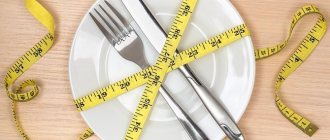Intermittent fasting for weight loss is a good way to lose weight, get your body in order, and remove toxins. The method has received good reviews and many people not only use intermittent fasting as a diet, some have even made it their usual diet.
A healthy diet for athletes is as important an element of their lifestyle as regular training. Any professional will tell you that physical activity without proper nutrition brings little benefit.
What is intermittent fasting
Intermittent fasting does not mean that a person will need to constantly fast. This is another good way to quickly lose weight and keep it within the desired range.
The essence of intermittent fasting is to divide the food intake cycle into two periods: a feeding period and a fasting period. The time period from the first meal of the day to the last is the feeding period, and the interval from the last meal to the first (including sleep) is the fasting period. An alternative name for the eating period is the dietary window.
The most effective weight loss occurs when all meals per day fit within a 6-8 hour period.
The essence of the diet
Intermittent fasting has many synonyms: periodic, cyclical, intermittent, etc. It is important to understand that this option has nothing to do with therapeutic fasting, which is occasionally offered by official medicine.
Article on the topic Minus kilograms, plus stones and gout. What are the dangers of fad diets?
Followers of this idea of losing weight claim that with the help of this method you can get rid of old chronic diseases, build muscle mass (which is why this option is often used by bodybuilders), and stabilize weight. Moreover, this option for combating excess weight is called more effective than all other diets.
In essence, this is a special restriction on the time of meals. When creating your diet and menu, you need to create periods when you cannot eat, but only drink water. Moreover, such intervals can be quite long: from 12 to 36 hours. Eating is allowed - in the standard version - only for 8 hours a day, which should include all meals. In this regard, intermittent fasting, a three-meal system is predominantly used. The time schedule can be varied depending on your work schedule, lifestyle and simply individual preferences.
Doctors are confident that this option has the right to life, but subject to strict adherence to a number of conditions. What you need to know about intermittent fasting in order not to harm your health, Tamara Gelashvili, a clinical-diagnostic endocrinologist (branch of GlavUpDK at the Russian Ministry of Foreign Affairs) ,
Before talking about intermittent fasting, it is worth noting that this technique should only be used under the guidance of a doctor; it has contraindications.
The essence of this diet plan is that eating is allowed only at certain times. The rest of the time - water and (in exceptional cases) vegetable and fruit juices. A day or week is divided into two time periods. You can eat everything in one period. In the other, you can’t do anything except drink. Depending on how these time periods relate, intermittent fasting is divided into several types. This can be either 16 hours of fasting and 8 hours of eating, or in a ratio of 14/10, or 5 days a week you can eat anything, and 2 days - limit yourself as much as possible, consuming no more than 500 kcal per day. There is a more radical option: daily fasting between meals.
Article on the topic
Italian biologist Valter Longo: “Fasting restores body cells”
The most obvious benefit of intermittent fasting is weight loss due to eating fewer calories. In addition, the body's sensitivity to insulin increases, which causes a decrease in the level of this hormone in the blood. This, in turn, forces the body to convert fat deposits into energy. There are studies that confirm the growth of new nerve cells in the body, that is, as a result of this diet, brain function improves.
Despite the huge number of types of intermittent fasting, the greatest results are achieved only by the so-called “dry” fasting, that is, refusal not only from food, but also from liquid.
The essence of “dry” fasting is that the body begins to experience stress, ceasing to receive nutrition. This, in turn, is the trigger for achieving the main healing effect of this diet: autophagy. Autophagy is a natural process that occurs in the human body at the cellular level. It reduces the risk of certain diseases and prolongs life. This is the process by which cells break down and recycle their components to provide an additional source of energy. This way they get rid of damaged proteins and fight the negative effects of aging in the body.
Proper implementation of “dry fasting” allows you to:
— increase immunity and stress resistance;
- cleanse the body;
- slow down cellular aging.
To achieve a positive effect, it is necessary to coordinate the diet and take into account the exact time of fasting. Otherwise, you may get the opposite effect.
Before you start changing your diet and resorting to certain types of fasting, in any case you need to consult a doctor to exclude contraindications.
Say goodbye to swelling! 6 ways to remove excess fluid from the body Read more
Benefits and harms
Intermittent fasting has obvious advantages:
- Accelerates the production of hormones. The body does not receive nutrition, insulin levels drop, and internal fat reserves begin to be used to maintain vital functions. Due to this, hormones are produced that stimulate an increase in muscle mass;
- Burns fats in the body. Fasting for such a long period forces the body to use up fat reserves;
- Acceleration of metabolism by 5-15%;
- Preservation of muscle mass;
- Reducing the risk of type 2 diabetes due to decreased insulin;
- Improving well-being, sleep quality and stress resistance;
- Increased performance, increased energy;
- Stabilization of the digestive system;
- Improving the condition of the skin;
- Reduces the amount of time a person spends on cooking;
- Doesn't require a lot of money.
But for some people, the intermittent fasting method is not suitable, and in some cases it can be harmful to health. The reasons may be the following:
- Possible problems with digestion, gastrointestinal upset, constipation, etc.;
- Belching, heartburn, discomfort in the stomach;
- Muscle spasms;
- Headaches, migraines, and dizziness occur due to a sudden transition to a different diet.
In any case, before starting to use the method, you should consult your doctor.
A nutritionist tells how to lose weight without restricting your diet
The question “What should I eat to lose weight?” no longer sounds like a joke. You can lose weight even by lying on your side. Functional nutrition specialists have revealed the secrets of losing weight without counting calories and switching to buckwheat and kefir.
Photo: depositphotos/stockasso
Lose weight in your sleep Intermittent fasting is called a diet for the lazy. According to fashionable ladies, this is the case when you can eat whatever you want and lose weight. It's all about when exactly to abstain from food. The classic scheme is that a person fasts for 16 hours, and for 8 hours he can eat almost whatever he wants. These numbers only look scary, because most of the fasting occurs... during sleep. To become a supporter of the fashionable system, you just need to give up early breakfast or late dinner.
“There are no calorie restrictions in this system,” says nutritionist, specialist in eating behavior correction, and expert in the field of healthy lifestyle Nonna Kovalevskaya. – The diet can be anything, the main thing is to fit it within the time interval. Moreover, you can choose this interval yourself - for example, from 12 to 20 o'clock or from 9 to 17. The diet is perfect for people who fall asleep late, because you can eat after 18, provided that breakfast was at noon. The lack of strictness, restrictions and the ability to vary your diet makes intermittent fasting an excellent option for anyone who wants to lose weight without harm to their health.
Away from the kitchen Nutritionist believes that the window of hunger should gradually be increased by an hour over the course of a week. First, increase the interval to 14 hours of abstinence from food, then to 16, and over time you can even up to 18 hours.
“Eating at the same time will help you get used to it and get into the schedule,” notes Nonna Kovalevskaya. – After an evening meal, it is better to leave the kitchen, not go shopping and restaurants, not cook, but do what you love - draw, embroider. A trip to the spa and your favorite music will distract you from thinking about food.”
Of course, efforts will be minimized if, during the period free from fasting, you pounce on food and chew everything in a row, destroying more than the daily norm. According to a healthy nutrition specialist, between fasting you can eat any healthy food, except for simple sugars, fast carbohydrates, smoked meats, sausages, etc. And the nutritionist determines the interval between meals at 4 hours. And here, of course, difficulties may arise for those who prepare food for their household or are accustomed to snacking frequently.
“For the first week, you need to delegate kitchen responsibilities to one of the family members,” notes Nonna Kovalevskaya. “Afterwards, addiction sets in and it will be easy to endure temptations.”
Photo: depositphotos/Subbotina
For what? Intermittent fasting is credited with miraculous properties. It is believed that it gives the body the opportunity to rest and promotes rejuvenation.
“Periods of fasting have a positive effect on cell renewal and help slow down the aging process,” notes the nutritionist. – Insulin and glucose levels will stabilize, which means the appearance of the skin will improve. The only negative can only arise if this type of nutrition is contraindicated for you, and you don’t know about it. It is imperative to do an examination to eliminate all risks. Intermittent fasting can be practiced by healthy adults, those who do not have eating disorders or gastrointestinal disorders.”
Intermittent fasting is not recommended:
- during exacerbation of chronic diseases;
- with Gilbert's syndrome;
- with cholelithiasis;
- for chronic fatigue syndrome;
- for gout;
- for eating disorders;
- with a history of menstrual irregularities;
- for problems with the thyroid gland;
- for liver disorders;
- with thrombophlebitis;
- for CVD (arrhythmia);
- as well as children, pregnant and nursing mothers.
Indications and contraindications
Intermittent fasting can be used in the following cases:
- The need to lose weight and activate metabolism in the body;
- The presence of nutritional obesity;
- The desire to cleanse the body of waste and toxins;
Contraindications include:
- Tuberculosis;
- Kidney problems;
- Oncological diseases;
- Diseases of the cardiovascular system;
- Hypertension;
- Stomach ulcer;
- Pregnancy;
- Diabetes;
- Problems with the nervous system.
Types of Intermittent Fasting
There are three main types of intermittent fasting:
- Classical. The eating window is 8 hours, the fasting period is 16 hours. Recommended time for eating: from 12 to 20 hours. You can adjust the time frame for yourself;
- Moderate. Of the 24 hours, 14 hours are spent on the fasting period, the remaining 10 are the dietary window. This option is easier for beginners, as it does not subject the body to severe stress;
- Daily. The most difficult option involves fasting for 24 hours between meals.
Beginners are advised to start with less extreme options and gradually increase the fasting period.
How to fast properly?
As an example, let’s take the most common type of intermittent fasting – 16/8. This option will be the easiest for you to start with. In addition, half of the fasting period will be spent sleeping (7-9 hours). For example, the day before you had dinner at 7 pm. Thus, your next meal will be in 16 hours - at 11:00 the next day. You then have eight hours to eat and gain energy.
Photo: istockphoto.com
In the evening, you can drink a glass of water or tea without sugar, and start the next morning with a cup of coffee, but also without sugar and, importantly, without milk. It affects blood sugar levels and triggers the release of insulin. In addition, you can shift your “fasting window.” For example, if you like to have breakfast early in the morning, you can move your dinner to an earlier time or skip it altogether.
To enhance the effect of intermittent fasting, it is better to choose only natural and whole foods, excluding the consumption of fast food. Regular jogging or walking throughout the day will also help.
Expensive pleasure: how much do abs cost?
Nutrition rules
Basic rules of nutrition while using intermittent fasting:
- During the dietary window, you need to consume the daily allowance of calories, dietary supplements and vitamins;
Calculate how many calories you need to eat per day. We have made a convenient calculator
- The highest calorie meal should be breakfast. During it, it is worth consuming complex carbohydrates, as well as animal fats, which are easily digestible;
- It is forbidden to consume store-bought juices, they contain a lot of sugar;
- You can’t eat simple carbohydrates – baked goods, baked goods. They are easily digestible, and after a while the person feels hungry again;
- Don't overeat during your diet window. 3-4 meals with small snacks is a good option;
- Remove processed foods, fast food and other unhealthy foods from your diet. This will help you lose weight faster;
- You need to drink your daily fluid intake. Water, green tea, celery juice are allowed;
- Meals after breakfast should be protein, for lunch you can eat carbohydrates and fats;
Intermittent fasting for weight loss involves some dietary restrictions. Be prepared to give up unhealthy foods, even if they are among your favorites.
Menu for a week, how often can you do intermittent fasting
Sample food menu for the week:
| Day | Breakfast | Dinner | Dinner |
| Monday | Cottage cheese with berries, green tea, bread | Chicken broth soup, carrot salad | Steamed fish, beet salad, cheese |
| Tuesday | Omelet, glass of water, fruit | Okroshka, Greek salad, orange juice | Turkey from the oven, kefir, vegetable salad |
| Wednesday | Oatmeal with milk, berries, green tea | Pasta with boiled chicken, fresh vegetables, kefir | Boiled eggs, stewed meat with vegetables, halva |
| Thursday | Curd casserole, honey, nuts | Chicken or turkey cutlets, vegetable salad, apples | Seafood with rice, cottage cheese, green tea |
| Friday | Pancakes with jam, boiled eggs, tea | Pasta with chicken in creamy sauce, pomegranate juice, sliced vegetables | Steamed fish, vegetable salad, tomato juice |
| Saturday | Cottage cheese with berries, green tea, omelette | Cheese soup, couscous, crushed cucumbers | Turkey risotto, cheese, kefir |
| Sunday | Cheesecakes, fruit salad, pomegranate juice | Chicken soup, pasta, Greek salad | Grilled chicken breast with vegetables, boiled potatoes, tomato juice |
The question about the frequency of application of the technique does not have a clear answer. It is recommended to gradually introduce the diet into the desired framework and adhere to this diet constantly.
If your goal is to lose weight, then using the method one to two weeks a month will be enough. The rate of weight loss will be noticeable from the first days, but will gradually slow down. In two weeks, on average, you can lose about 5 kg.
Efficiency in losing weight
Intermittent fasting for weight loss for women is a good method that can quickly bring the body to the desired weight. Each person’s body is individual, so each case should be considered individually.
According to reviews, one month of eating according to the plan can reduce weight by 5 kg. If you strictly follow all the rules and regulations, and also start playing sports and devote time to cardio training two or three times a week, the effect will be even better and you will be able to lose weight many times faster.
However, there are opposite examples when the body does not accept the method of intermittent fasting and weight loss either does not occur, or, on the contrary, the amount of body fat increases. If you feel very stressed while fasting, this method is not for you.
How to keep fit
Having obtained the desired result, you need to regularly maintain your shape to stay in good shape. Following these rules will help you do this:
- You need to sleep at least eight hours a day. At this time, the body completely relaxes and rests, and metabolic processes work;
- Take the fasting method more simply, don’t get hung up on it. This will help you avoid stress and always be in a good mood;
- Live an active life - it distracts from the feeling of hunger and promotes weight loss;
- You can start using special anti-cellulite massages. They activate blood flow and also accelerate metabolic processes;
- The maximum effect in terms of weight loss can be achieved if the diet is combined with cardio exercise. Set aside two to three days a week for training and exercise regularly;
- Drink more clean water. The feeling of hunger will dull for a while, you will be able to control your appetite.
Fasting for weight loss
2. Method 5:2: Diet 2 days a week
© konstiantynzapylaie
The 5:2 diet involves eating normally for 5 days and restricting to 500-600 calories 2 days a week.
.
This method of intermittent fasting was proposed by British journalist and physician Michael
Mosley.
On restriction days, women are advised to eat about 500 calories, and men about 600.
For example, you eat as usual on all days except Monday and Thursday, when you eat two small meals (about 250 calories each) per day.











